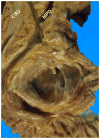Pathologic Evaluation and Reporting of Intraductal Papillary Mucinous Neoplasms of the Pancreas and Other Tumoral Intraepithelial Neoplasms of Pancreatobiliary Tract: Recommendations of Verona Consensus Meeting
- PMID: 25775066
- PMCID: PMC4568174
- DOI: 10.1097/SLA.0000000000001173
Pathologic Evaluation and Reporting of Intraductal Papillary Mucinous Neoplasms of the Pancreas and Other Tumoral Intraepithelial Neoplasms of Pancreatobiliary Tract: Recommendations of Verona Consensus Meeting
Abstract
Background: There are no established guidelines for pathologic diagnosis/reporting of intraductal papillary mucinous neoplasms (IPMNs).
Design: An international multidisciplinary group, brought together by the Verona Pancreas Group in Italy-2013, was tasked to devise recommendations.
Results: (1) Crucial to rule out invasive carcinoma with extensive (if not complete) sampling. (2) Invasive component is to be documented in a full synoptic report including its size, type, grade, and stage. (3) The term "minimally invasive" should be avoided; instead, invasion size with stage and substaging of T1 (1a, b, c; ≤ 0.5, > 0.5-≤ 1, > 1 cm) is to be documented. (4) Largest diameter of the invasion, not the distance from the nearest duct, is to be used. (5) A category of "indeterminate/(suspicious) for invasion" is acceptable for rare cases. (6) The term "malignant" IPMN should be avoided. (7) The highest grade of dysplasia in the non-invasive component is to be documented separately. (8) Lesion size is to be correlated with imaging findings in cysts with rupture. (9) The main duct diameter and, if possible, its involvement are to be documented; however, it is not required to provide main versus branch duct classification in the resected tumor. (10) Subtyping as gastric/intestinal/pancreatobiliary/oncocytic/mixed is of value. (11) Frozen section is to be performed highly selectively, with appreciation of its shortcomings. (12) These principles also apply to other similar tumoral intraepithelial neoplasms (mucinous cystic neoplasms, intra-ampullary, and intra-biliary/cholecystic).
Conclusions: These recommendations will ensure proper communication of salient tumor characteristics to the management teams, accurate comparison of data between analyses, and development of more effective management algorithms.
Figures





References
-
- Sessa F, Solcia E, Capella C, et al. Intraductal papillary-mucinous tumours represent a distinct group of pancreatic neoplasms: an investigation of tumour cell differentiation and K-ras, p53 and c-erbB-2 abnormalities in 26 patients. Virchows Arch. 1994;425:357–367. - PubMed
-
- Itai Y, Ohhashi K, Nagai H, et al. “Ductectatic” mucinous cystadenoma and cystadenocarcinoma of the pancreas. Radiology. 1986;161:697–700. - PubMed
-
- Yamada M, Kozuka S, Yamao K, et al. Mucin-producing tumor of the pancreas. Cancer. 1991;68:159–68. - PubMed
-
- Yamaguchi K, Tanaka M. Mucin-hypersecreting tumor of the pancreas with mucin extrusion through an enlarged papilla. Am J Gastroenterol. 1991;86:835–9. - PubMed
Publication types
MeSH terms
Grants and funding
LinkOut - more resources
Full Text Sources
Other Literature Sources
Medical

